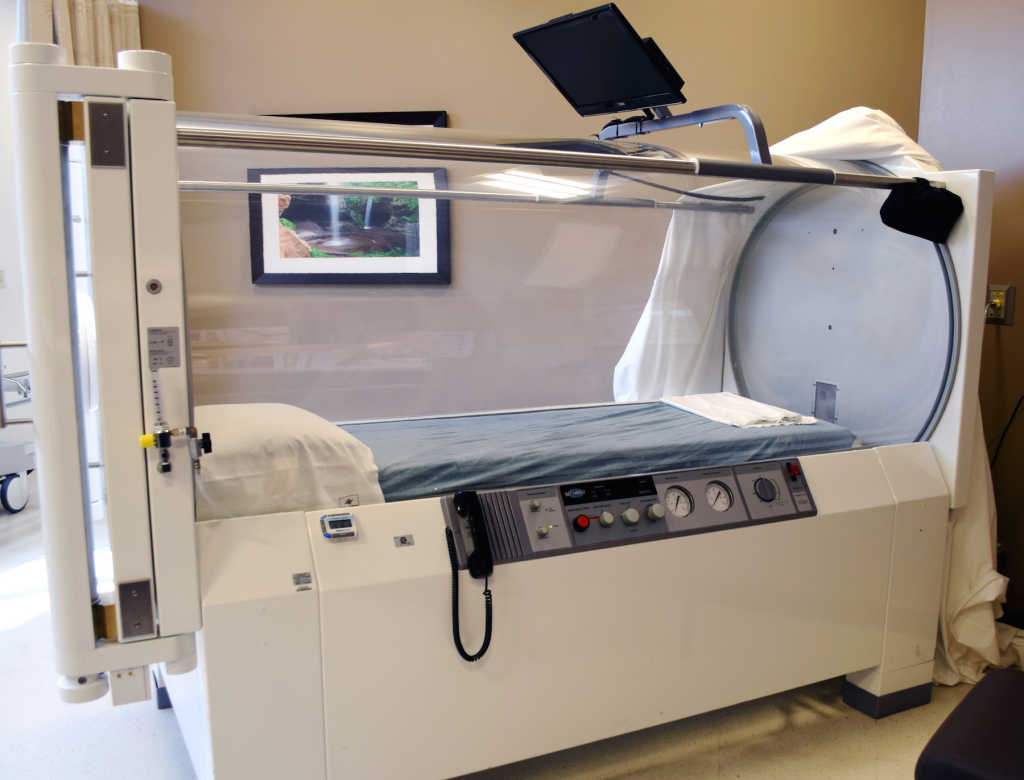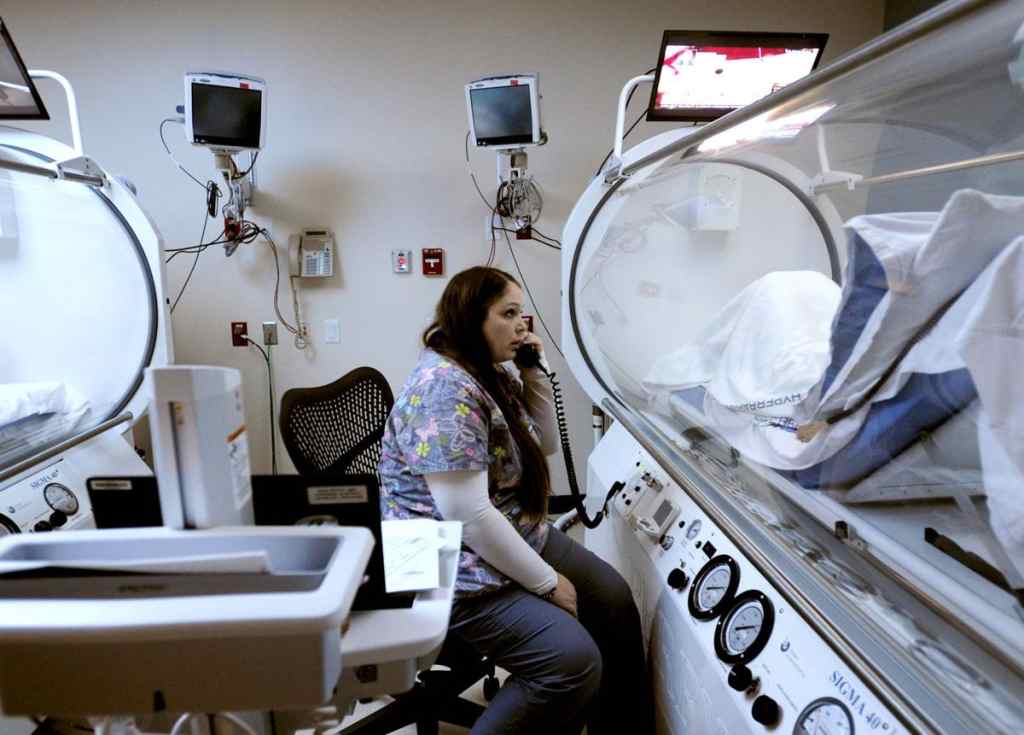How is hyperbaric oxygenation carried out?
hyperbaric oxygenation is a common cause of deterioration of well-being and the appearance of pathological processes. It is found in residents of megacities, where the oxygen content is at the lower limit of normal.
People with a history of injuries and illnesses develop serious complications. This is due to poor transportation of this gas to the body systems in need. Hyperbaric oxygenation will help saturate the body with the missing substance. About the procedure, its contraindications and benefits, read in this article.
Content
- What is HBOT
- Indications
- In what cases is contraindicated
- Hardware Features
- Preparatory Activities
- Methodology
- Advantages and disadvantages
- Useful video: Features of the HBOT procedure
What is HBOT
Hyperbaric oxygenation is the filling of the body with oxygen. The substance, being under high pressure, easily enters the cells and tissues of the body. It is used to treat diseases and for general healing of the body. It is carried out in special pressure chambers under the supervision of a specialist.
Conducted in combination with other medical procedures and as an independent therapy.
Indications
They are used in surgery, gastroenterology, nephrology, toxicology, otolaryngology, neurology and other fields.
Any condition causing a lack of oxygen in the organs and tissues of the body is an indication for the use of hyperbaric oxygenation. For example, respiratory or heart failure entail circulatory disorders and organ hypoxia.
A number of procedures will reduce oxygen starvation, prevent decay and start cell recovery.
Indications include:
- burns and severe injuries;
- frostbite;
- diseases of the respiratory system;
- heart disease and their prevention, recovery after heart surgery;
- disturbances in the functioning of arterioles, capillaries, causing skin diseases;
- instability of mental state;
- autoimmune diseases;
- diabetes;
- intoxication;
- traumatic toxicosis;
- 1-2 degree of arterial hypertension;
- the presence in the blood of gases that should not be there;
- ONST (acute sensorineural hearing loss);
- diving disease;
- prevention of hypoxia.
In what cases is contraindicated
In some cases, it can cause seizures in patients with epilepsy. Therefore, if there is a history of this diagnosis, HBOT procedures are not prescribed. An exception may be situations. When cramps arose as a result of a blow to the head and stopped after removal of the hematoma. Then the doctor must conduct an EEG and monitor the patient's condition.
People with fear of confined spaces have panic attacks. HBOT is carried out in closed pressure chambers.
Inhaling gas under pressure is dangerous to hyper- and hypotension. Possible complications in certain lung diseases. SARS and other infections accompanied by fever up to 38 ° C and above are also a contraindication.
With increased sensitivity to this element or any other unpleasant sensation, hyperbaric oxygenation is not carried out.
Hardware Features
The devices vary in capacity. Single pressure chambers are used to treat adults, adolescents and primary school students, if they are not afraid. The patient is inside lying down.
The pressure chamber itself has several windows or a completely transparent case. Allowing health workers to see the face of the patient and monitor his condition.
It is tight and does not let in air from the outside. There is an intercom and monitoring sensors.
A person, being inside, finds himself in a specific gas environment: additional means for breathing are not required.
Multiple devices can accommodate several people. People are lying down, a doctor or a nurse is present in the pressure chamber. Young children undergo a session with a medical professional.
The pressure chamber environment is the air that the specialist breathes, and the patient receives oxygen through an individual compressor. Pressure is created in the air with which the chamber is filled.
Preparatory Activities
HBOT therapy is primarily a medical procedure that requires appropriate training. Before carrying out it, the patient donates blood for analysis, makes an electrocardiogram and chest x-ray.
If critical changes in the work of the heart and blood counts are not detected, the patient is referred to specialists of other profiles.
Be sure to see an ENT doctor and a neurologist.
If contraindications are not identified, a complex of procedures is prescribed.
The doctor asks the patient about changes in well-being in the department of hyperbaric oxygenation. This allows him to control before the procedure.
Upon receipt of an injury, bleeding that has opened, or infection, manipulation is delayed.
Before holding HBOT, it is forbidden to apply oils, creams, ointments to the surface of the skin. The patient needs:
take a shower and dry your skin thoroughly with a towel;
Wear sterile clothing
remove jewelry, watches, dentures.
Patients who cannot complete the training themselves receive the help of medical personnel.
On the bed they are transferred to sheets, ointments are removed from the skin and changed. Check the equipment, the reliability of the catheter and drainage, if any.
Methodology
The whole process is under the supervision of a doctor. He monitors the patient’s reaction to changes in the pressure chamber, checks the pulse, checks the indicators of devices. The patient at this time lies and breathes oxygen.
He informs the doctor about the unpleasant sensations through the intercom.
Parents or officials can show cartoons or a book through transparent glass to young children.
The course usually lasts 5-20 sessions. The first session is always carried out in a gentle mode: moderately increase the pressure and observe the patient's sensations.
An increase in heart rate, anxiety, a change in breathing are signs indicating the negative impact of HBO. In this case, the patient is removed from the pressure chamber or the sequence and frequency of the regimes are adjusted.
If the first session was successful, the pressure in the chamber is increased, the flow of oxygen is gradually increased. Ear pain may appear in the beginning. The doctor lowers the pressure and then rises again and the pain goes away.
The rest of the painful and unpleasant sensations should not be. Sometimes signs of intoxication appear later, so the control by the medical staff should not weaken.
Advantages and disadvantages
HBOT has a positive effect on the underlying disease or injury. Body organs and cells suffering from hypoxia are saturated with oxygen. The procedure allows you to reach the inaccessible corners of the body.
Due to this, blood circulation improves and a complex detoxifying effect occurs, the metabolism is leveled.
In addition, a person begins to feel more cheerful, his mood rises, his muscles relax. The effects of stress are removed, immunity is restored, brain activity increases, and physical endurance increases.
Hyperbaric oxygenation in many respects has a positive effect on the human condition. Patients note a cheerfulness charge, lightness and improved mood after the session. They feel rested and joyful.
Manipulation can harm the body in the following cases:
the patient has contraindications, which he did not report before HBOT;
individual reaction to the supply of oxygen under pressure;
humidity and air temperature in the pressure chamber are not normal, the concentration of carbon dioxide is increased;
negligence and lack of qualification of doctors.
For these reasons, complications in the form of acute or chronic oxygen poisoning can occur. The consequences do not appear immediately. There is tachycardia, nausea and vomiting, visual impairment, muscle cramps, cramps. According to doctors, oxygen intoxication is rare







